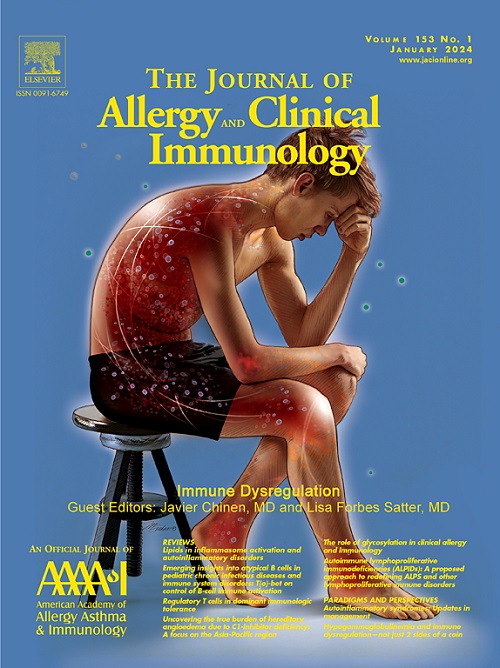哮喘患者2型嗜酸性粒细胞炎症相关支气管上皮基因的鉴定。
IF 11.4
1区 医学
Q1 ALLERGY
引用次数: 0
摘要
背景:气道炎症在哮喘发病机制和病理生理中起着重要作用。然而,导致气道炎症的分子途径尚不完全清楚,特别是以嗜酸性粒细胞增多和高FeNO水平为特征的2型(T2)炎症。目的:寻找与支气管肺泡灌洗(BAL)嗜酸性粒细胞增多和FeNO产生相关的基因。方法:我们对哮喘患者进行了部分过敏原支气管激发(SBP-Ag),并对SBP-Ag前后48 h的BAL细胞和刷牙样本进行了rna测序(RNA-seq)分析,以确定嗜酸性粒细胞募集和FeNO变化的调节。结果:过敏原支气管刺激使FeNO水平升高,与嗜酸性粒细胞增多相关。在刷毛样品中鉴定出13个基因,这些基因的表达随SBP-Ag的变化而变化,并与SBP-Ag后气道嗜酸性粒细胞和FeNO水平相关。在这13个基因中,上皮细胞产物CDH26/cadherin-26有助于T2炎症的扩增,这反映在嗜酸性粒细胞和FeNO上,以及BAL液中亲T2和亲嗜酸性细胞因子介质的因果中介分析。在与嗜酸性粒细胞减少和FeNO相关的基因中,已知HEY2可以增强细胞增殖、迁移、侵袭和上皮-间质转化(EMT),并减少细胞凋亡。结论:这项针对过敏性哮喘患者的无偏倚RNA-seq分析揭示了几个上皮细胞基因,特别是CDH26,可能对哮喘患者T2炎症的发展或增强至关重要。本文章由计算机程序翻译,如有差异,请以英文原文为准。

Identification of bronchial epithelial genes associated with type 2 eosinophilic inflammation in asthma
Background
Airway inflammation plays a critical role in asthma pathogenesis and pathophysiology, but the molecular pathways contributing to airway inflammation are not fully known, particularly type 2 (T2) inflammation characterized by both eosinophilia and higher fractional exhaled nitric oxide (Feno) levels.
Objective
We sought to identify genes whose level of expression in epithelial brushing samples were associated with both bronchoalveolar lavage (BAL) eosinophilia and generation of Feno.
Methods
We performed segmental allergen bronchoprovocation (SBP-Ag) in participants with asthma, then RNA sequencing analyses of BAL cells and brushing samples before and 48 hours after SBP-Ag to identify regulation of eosinophil recruitment and Feno changes.
Results
Allergen bronchoprovocation increased Feno levels, which correlated with eosinophilia. Thirteen genes were identified in brushing samples, whose expression changed in response to SBP-Ag and correlated with both airway eosinophilia and Feno levels after SBP-Ag. Among these 13 genes, epithelial cell product CDH26/cadherin-26 contributed to the amplification of T2 inflammation, as reflected by eosinophilia and Feno, and causal mediation analyses with pro-T2 and proeosinophilic cytokine mediators in BAL fluids. Among the genes associated with reduced eosinophilia and Feno, HEY2 is known to enhance cell proliferation, migration, invasion, and epithelial-to-mesenchymal transition, as well as to reduce apoptosis.
Conclusion
This unbiased RNA sequencing analysis in participants with allergic asthma revealed several epithelial cell genes, particularly CDH26, that may be critical for the development or augmentation of T2 inflammation in asthma.
求助全文
通过发布文献求助,成功后即可免费获取论文全文。
去求助
来源期刊
CiteScore
25.90
自引率
7.70%
发文量
1302
审稿时长
38 days
期刊介绍:
The Journal of Allergy and Clinical Immunology is a prestigious publication that features groundbreaking research in the fields of Allergy, Asthma, and Immunology. This influential journal publishes high-impact research papers that explore various topics, including asthma, food allergy, allergic rhinitis, atopic dermatitis, primary immune deficiencies, occupational and environmental allergy, and other allergic and immunologic diseases. The articles not only report on clinical trials and mechanistic studies but also provide insights into novel therapies, underlying mechanisms, and important discoveries that contribute to our understanding of these diseases. By sharing this valuable information, the journal aims to enhance the diagnosis and management of patients in the future.

 求助内容:
求助内容: 应助结果提醒方式:
应助结果提醒方式:


